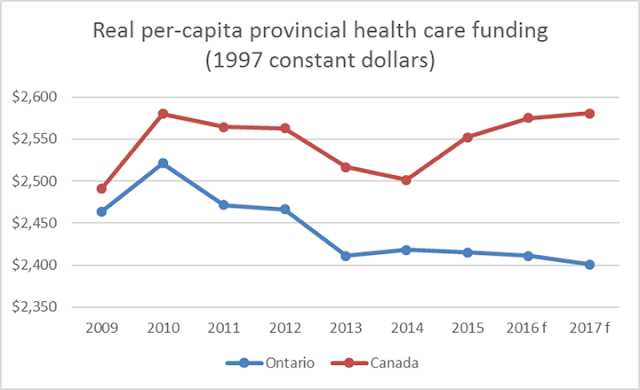Across Canada real per person funding is in its fourth consecutive year of increase. Since 2009, real provincial funding across Canada is up $89 -- 3.6%.
In fact the funding gap between Ontario and Canada as a whole has gown consistently for years (as set out below in current dollars).
Ontario funds health care less than any other province -- indeed, the province that funds health care the second least (B.C.) provides $185 more per person per year, 4.7% more.
Provincial health care spending in the rest of Canada (excluding Ontario) is now $574 higher per person annually than in Ontario.
Private expenditures on health care have exceeded Ontario government increases for the last three years. Since 2011, private expenditures on health have increased 3.9% annually, while provincial expenditures increased 2.3% annually.
Starting in 2010, provincial government health care funding increases in Ontario began to fall, hitting just 1% in 2012. Hospital funding increases continued downward in 2013 hitting just above 0% in 2013, recovering somewhat in 2014 and 2015. Funding increases for doctors were quite a bit higher, despite the alleged attack on their incomes.
Below is a chart with the provincial government per person dollar funding since 2008 in real dollars (using constant 1997 dollars). In 2017, real funding per person was still less than in 2008 -- although the Ontario economy is about 17% larger than it was in 2008.
The hysteria from the right about runaway health care cost is just that -- hysteria.

Two-thirds of this dollar cut came from cuts to hospital funding. Since 2010/11 real provincial hospital expenditures have been cut 8.3%.
That is $81 per person per year in constant 1997 dollars, or $128 per person in today's money.
In fact real provincial expenditures on hospitals are lower than they were in 1991 -- despite an increase in the median age in Ontario from 33.3 years to 40.6 years and a doubling of the population over 65 (and even bigger increases in the population over 85).
In 1991, Ontario spent more per-person on hospitals than Canadian provinces and territories as a whole, but now Ontario falls far behind.
The provincial government has promised a 4.5% health care funding increase for 2018/19. That should result in at least a one-year real per-person funding increase for 2018. But it is not enough to reverse the decline of recent years. Worse, the government also quietly notes that it will revert to a lower increase in 2019/20 -- once the provincial election is over.
The data for the charts above comes from the Canadian Institute for Health Information National Health Expenditure Trends 1975-2017 data tables with the relevant tables copied below:
- https://www.scribd.com/document/365092234/Chart-Cihi-Provincial-Gov-Health-Funding-2017-11 ,
- https://www.scribd.com/document/365093199/Chart-Cihi-Increases-Health-Expenditures-Private-Provincial-2017 ,
- https://www.scribd.com/document/365093456/chart-cihi-provincial-expenditure-by-sector-2017-xlsx ,
- https://www.scribd.com/document/365093704/Chart-Cihi-Per-Capita-Provincial-Expenditure-2017
- https://www.scribd.com/document/365397742/chart-provincial-hospital-expemditure-percapita-real1997-1975-2017









Comments
Post a Comment